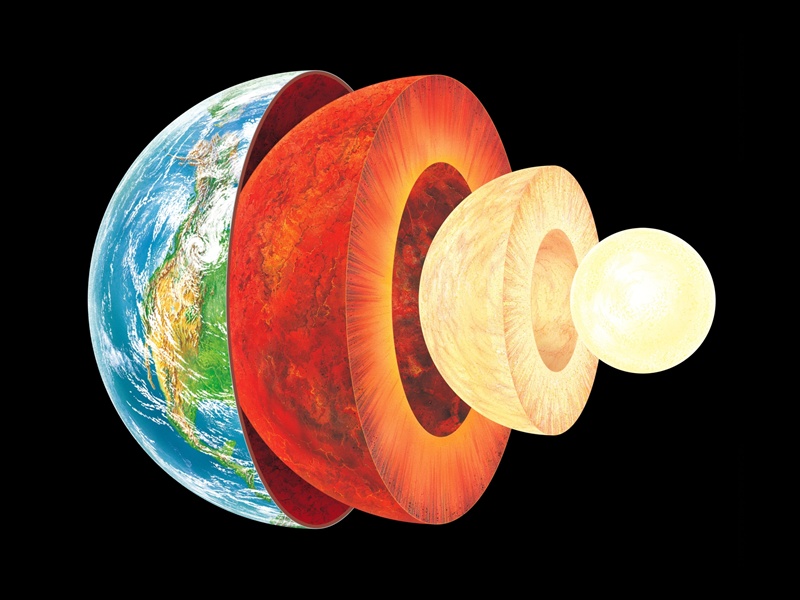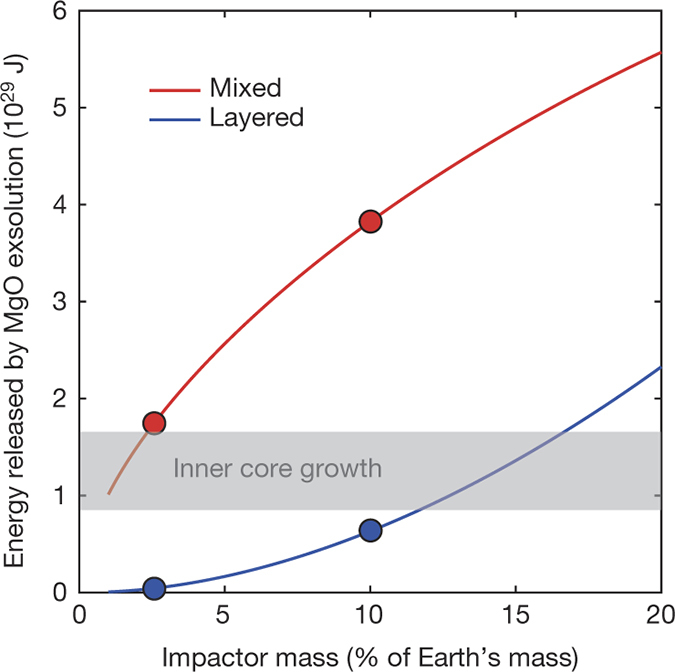Title: An early geodynamo driven by exsolution of mantle components from Earth’s core
Authors: James Badro, Julien Siebert & Francis Nimmo
First Author’s Institution: Institut de Physique du Globe de Paris, France; EPFL Lausanne, Switzerland
Status: Published in Nature, 18 July 2016
The enigmatic power source of the early geodynamo

Fig. 1: Inner structure of the Earth, with (from right to left) inner core, outer core, mantle and crust + surface. (Gary Hincks/Science Photo Library)
Luckily, our home planet harbours a magnetic field which surrounds and shields us from harmful radiation from space. The energy source for this comes from the liberation of potential energy in the core. The inner and outer core exchange material (mostly metal alloys, like iron and nickel), which lets the inner, solid core grow over time. The liberation of potential energy gives then rise to the magnetic field, because of which we are all here, writing or reading these lines…
Surprisingly, the comparison of theoretical estimates from the inferred cooling history of the core with geological data from ancient rock records reveals a conundrum. The solid inner core came into being just around one billion years ago, while rock samples from a lot older (~3.5 billion years ago) show the magnetic imprint of an external magnetic field nonetheless! This is very weird, as you would guess that there was no magnetic field when Earth did not have the current energy source to drive the geodynamo, which generated the magnetic field.

Fig. 2: Potential energy released from magnesium oxide which leaves the core and enters the planetary mantle. The red curve assumes that the added and old core components are perfectly mixed, the blue one assumes that the new material is layered on top of the old core. The dots indicate the cases of an impactor size of Mars (~10% of Earth’s mass) or smaller (~2.5% of Earth’s mass). The gray band shows the energy release today which drives the current geodynamo and serves as a comparison. Image source: Nature
The Moon-forming impact to the rescue
There was envisioned an alternate power source to bridge the time before the onset of the current driving mechanism: exsolution (release or transfer) of magnesium oxide from the core to the mantle. Usually, the core is supposed to be comprised mostly of heavy metals like iron and nickel. However, a massive giant impactor, like the one which likely formed the moon, could have injected enormous amounts of lighter elements into the core. When a giant impactor of at least a few percent of Earth’s mass crashes into the planet it will rapidly sink into the center of the Earth. The impactor itself has a core just like Earth and the two cores will merge. However, the sink velocity is so fast that elements which usually do not sit in cores will just follow the impactor core the Earth’s center.
The result is that we have a massive amount of material in the core which does not belong there. Magnesium oxide is the most important impactor contribution to the merged core of material which usually goes into the planetary mantle. What does it do? Over time, when the core cools, the elements will separate from each other to reestablish the ‘correct’ physiochemical ordering: heavy elements at the bottom, lighter elements on top. The current composition of the mantle is inferred to be able to bear a value of 1.1 weight percent of magnesium oxide. Everything above this will leave the core over time. Eureka! And again we have found potential energy liberation! 🙂

Fig. 3: Onset and time evolution of energy release from magnesium oxide exsolution from the core material after addition by a giant impact for two different cases. (a) Magnesium oxide concentration in the core versus time. As the magnesium oxide is release from the core and transferred from the mantle, its concentration in the core decreases. (b) Energy liberation over time for a Mars-sized impactor. After ~1.1 billion years the core cooled enough that magnesium oxide can be released from the core. After the excess magnesium oxide is released the inner core starts to grow and the major power source of the geodynamo changes from magnesium exsolution to inner core growth. (c) Same as in (b) for a smaller impactor mass of 2.5% the mass of the Earth. Because the added amount of magnesium oxide is lower the exsolution and thus powering of the geodynamo starts later. Image source: Nature
How does the added material release energy?
If you envision the scenario of an impactor core sinking down to Earth’s center and merging with the old core, an important questions arises: will the merge be perfect or will the added core-material just casually linger on top of the old core? We do not know the answer to this, as our understanding of material properties and physiochemical reactions under such extreme conditions are limited. Therefore, the authors tried out both extremes, as pictured in Figure 2. One extreme is complete and perfect mixing of the new core with old one. The other one is that the new core material just sinks onto the top of the old one and stays there. The difference in liberated potential energy from exsolution of magnesium oxide is quite different.
This tells us that a different layering of the additional material changes the total energy output. But what if the total amount of added material is changed? Counter-intuitively, as shown in Figure 3, more magnesium oxide does not change the energy release. However, it does change the onset of the energy liberation. This is because the amount of magnesium oxide changes the cooling regime of the core and the onset of magnesium oxide exsolution into the mantle depends solely on core temperature. This means that the duration the dynamo can be powered by this mechanism varies, depending on the amount of added material. Thus, large impacts power longer-term dynamos than smaller impactors, all in relation to the total amount of material present in the planet before the giant impact.
Where’s the ‘astro’ part?
The mechanism of magnesium exsolution driving an early planetary dynamo is important in relation with our understanding of how planets form in general. The latest stages of the formation of terrestrial planets are usually thought to be dominated by late giant impacts, meaning that the likelihood of late addition of material is quite high for planets on inner orbits like Mercury, Venus, Earth or Mars. Also, the mechanism works better for more massive planets. And with the exoplanet revolution in the last two decades we got to know a lot of such planets: very massive, on inner orbits and presumably composed of rocks like Earth — super-Earths. These planets are a perfect target for late giant impacts and therefore it might be that many of these worlds harbour dynamos driven by the mechanism proposed in the study. So then, let’s go out and find them…
Featured image from this website.





I would be bothered by observing just one of 4 terrestrials having the exsolution geodynamo, despite a recent paper predicting at least one impact and 3 as median on Earth analogs. [ https://arxiv.org/abs/1511.03663 ]
Not that geodynamo models aren’t fine-tuned like the one here, but the 1 Ga inner core result is dependent on a recently revised thermal conductivity estimate. [ http://adsabs.harvard.edu/abs/2015PEPI..247…36L ; the paper reference ] Has this become consensus, and how robust is it?
Hi Torbjörn, thank for your interest in the article! 🙂 I agree with you, the mode presented above definitely falls in the ‘high-risk-high-gain’ category. 😉 Honestly, I do not know whether the 1 Gyr inner core age has become consensus, and there have been other papers describing the idea of the exsolution dynamo (see references in the paper itself). From my understanding the important part here is the lab measurement and combination with model estimates, which lead to the conclusion that the energy gain from exsolving magnesium oxide may be in the right regime. Regarding the other terrestrial Solar System planets I would not worry too much. Sure, the Solar System must always be our ‘fiducial system’, but because the diversity of planets and planetary systems is so large, it can only be one case of many, and not the ‘standard planetary system’. Additionally, even if at some point it can be shown that there was no exsolution dynamo on Earth, the model and following debate in the community will certainly pave the way to a more thorough understanding of the dynamo mechanism itself. 🙂